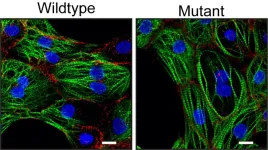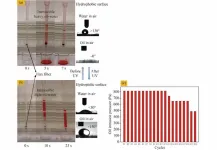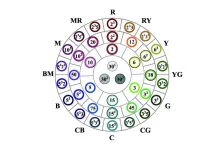New mutation in the desmoplakin gene leads to ACM
2023-03-02
(Press-News.org)
Researchers from the group of Eva van Rooij in collaboration with the UMC Utrecht identified a new mutation that leads to the cardiac disease arrhythmogenic cardiomyopathy (ACM). They assessed the effect of this mutation on heart muscle cells and obtained new insights into the underlying mechanism that causes the disease. The results of this study, published on March 2nd in Stem Cell Reports, could contribute to the development of new treatments for ACM.
Desmosomes
Millions of heart muscle cells contract to let the heart fulfill its pumping function. To make sure these contractions are executed well, it is important that the individual heart muscle cells communicate with each other. Therefore, heart muscle cells have to be tightly connected with each other. In a healthy heart, these connections are made up of complex protein structures that form a bridge between the cells, so called desmosomes. When mutations occur in genes that contribute to these structures, this can lead to the development of arrhythmogenic cardiomyopathy (ACM). ACM is a progressive and often hereditary disease in which the heart fails to contract properly. Even though 1 in 5000 people develop ACM throughout life, a lot remains unknown about the disease and no effective treatment options exist to cure patients.
Discovery of a new mutation
“We investigated the genetic material of an ACM patient and encountered a previously unknown mutation in the gene desmoplakin,” says first author of the study Sebastiaan van Kampen. Desmoplakin is one of the genes that is responsible for the formation of desmosomes. To investigate the role of this mutation in ACM onset, the researchers cultured heart muscle cells from the patient in the lab. Van Kampen: “We compared these heart muscle cells to the same heart muscle cells in which we repaired the mutation using CRISPR/Cas9. The heart muscle cells that contained the mutation turned out to be less tightly connected”. In addition, the researchers discovered that these cells have fewer of ion channels. These channels are crucial for efficient propagation of the action potential, an electrical signal that stimulates contraction, between heart muscle cells. From this, they concluded that the new mutation can lead to ACM in patients.
Underlying mechanism
Multiple mutations are known to lead to ACM. Nevertheless, the underlying mechanism that leads to the disease remains largely unknown. To change this, the researchers used the cultured heart muscle cells from the patient as a model for the disease. They discovered that a protein named PITX2 is more highly expressed in the “diseased” heart muscle cells and that this protein is in part responsible for the loss of desmosomes and ion channels. “When we removed the protein from the diseased heart muscle cells, the levels of ion channels and desmosomal proteins in the cells of the patient showed a remarkable recovery,” explains Van Kampen. The PITX2 protein thus plays an important role in the changes in the mutated heart muscle cells.
Future treatments
The study, published in Stem Cell Reports, can potentially contribute to the development of new treatments for ACM. Furthermore, the findings from this study offer new insights into the development of ACM that can be valuable for future research. “Although we don’t know how the new mutation leads to increased levels of PITX2, we see the same happening in a second mutation. It’s possible that increased levels of PITX2 lead to ACM in the context of many more mutations,” says Eva van Rooij, group leader at the Hubrecht Institute and last author of the study. More research into these different mutations is therefore essential.
---
Eva van Rooij is group leader at the Hubrecht Institute and professor of Molecular Cardiology at the UMC Utrecht.
About the Hubrecht Institute
The Hubrecht Institute is a research institute focused on developmental and stem cell biology. Because of the dynamic character of the research, the institute as a variable number of research group, around 20, that do fundamental, multidisciplinary research on healthy and diseased cells, tissues and organisms. The Hubrecht Institute is a research institute of the Royal Netherlands Academy of Arts and Sciences (KNAW), situated on Utrecht Science Park. Since 2008, the institute is affiliated with the UMC Utrecht, advancing the translation of research to the clinic. The Hubrecht Institute has a partnership with the European Molecular Biology Laboratory (EMBL). For more information, visit www.hubrecht.eu.
END
[Attachments] See images for this press release:

ELSE PRESS RELEASES FROM THIS DATE:
2023-03-02
WASHINGTON, DC – The Patient-Centered Outcomes Research Institute (PCORI) today kicked off a multiyear initiative with an initial investment of $50 million to advance the uptake of practice-changing comparative clinical effectiveness research results into health care practice with the selection of 42 U.S. health systems to participate in its groundbreaking Health Systems Implementation Initiative (HSII). In addition, PCORI initiated the first in two stages of HSII funding, focusing on initial capacity-building efforts.
The array of participating health systems representing a wide range of care settings and populations will develop and implement ...
2023-03-02
High in a narrow, seawater-filled crevasse in the base of Antarctica’s largest ice shelf, cameras on the remotely operated Icefin underwater vehicle relayed a sudden change in scenery.
Walls of smooth, cloudy meteoric ice suddenly turned green and rougher in texture, transitioning to salty marine ice.
Nearly 1,900 feet above, near where the surface of the Ross Ice Shelf meets Kamb Ice Stream, a U.S.-New Zealand research team recognized the shift as evidence of “ice pumping” – a process never before directly observed in an ice shelf crevasse, important to its stability.
“We were looking at ice that ...
2023-03-02
Party loyalty and partisan motivation may interfere less with Americans’ thinking than previously believed, MIT behavioral researchers Ben M. Tappin, Adam J. Berinsky, and David G. Rand report in new research published in the journal Nature Human Behaviour.
The study, which looked at how Democrats and Republicans react to persuasive messaging that doesn't align with their party leader’s position, challenges the view that party loyalty distorts how Americans process evidence and arguments.
“Our results are clear and unequivocal: Learning the in-party leader’s ...
2023-03-02
Even in their dark isolation from the atmosphere above, caves can hold a rich archive of local climate conditions and how they've shifted over the eons. Formed over tens of thousands of years, speleothems — rock formations unique to caves better known as stalagmites and stalactites — hold secrets to the ancient environments from which they formed.
A newly published study of a stalagmite found in a cave in southern Wisconsin reveals previously undetected history of the local climate going back thousands of years. The new findings provide strong ...
2023-03-02
• The blood-brain barrier prevents most drugs from reaching brain tumors.
• A new method using nanoparticles transported drugs across this barrier in mice.
• The nanoparticles target a protein on tumor blood vessel cells called P-selectin.
• The nanoparticles improved the treatment in a model of aggressive pediatric brain cancer
Brain tumors are notoriously hard to treat. One reason is the challenge posed by the blood-brain barrier, a network of blood vessels and tissue with closely spaced cells. The barrier forms a tight seal to protect ...
2023-03-02
Göttingen, March 2, 2023. A sense of fairness has long been considered purely human – but animals also react with frustration when they are treated unequally by a person. For instance, a well-known video shows monkeys throwing the offered cucumber at their trainer when a conspecific receives sweet grapes as a reward for the same task. Meanwhile, researchers have observed similarly frustrated reactions to unfair rewards in wolves, rats and crows. However, researchers still debate the reasons for this behavior: Does the frustration really stem from a dislike of unequal treatment, or is there another explanation? In a study with long-tailed ...
2023-03-02
Researchers from Bochum and Saarbrücken have detected security vulnerabilities, some of them serious, in several drones made by the manufacturer DJI. These enable users, for example, to change a drone’s serial number or override the mechanisms that allow security authorities to track the drones and their pilots. In special attack scenarios, the drones can even be brought down remotely in flight.
The team headed by Nico Schiller of the Horst Görtz Institute for IT Security at Ruhr University Bochum, ...
2023-03-02
New research led by Scripps Institution of Oceanography at UC San Diego has confirmed that coastal water pollution transfers to the atmosphere in sea spray aerosol, which can reach people beyond just beachgoers, surfers, and swimmers.
Rainfall in the US-Mexico border region causes complications for wastewater treatment and results in untreated sewage being diverted into the Tijuana River and flowing into the ocean in south Imperial Beach. This input of contaminated water has caused chronic coastal water pollution in Imperial ...
2023-03-02
The large number of oily wastewater discharges and oil spills are bringing about severe threats to environment and human health. Corresponding to this challenge, a number of functional materials have been developed and applied in oil-water separation as oil barriers or oil sorbents. These materials can be divided into two main categories which are artificial and natural.
Natural materials such as green bio-materials are generally low cost and abundant with biological degradability, which are also regarded as promising alternatives for oil-water separation ...
2023-03-02
Existing colour systems, such as RGB and CYMK, are all text-based and require a large range of values to represent different colours, making them difficult to compute and time-consuming to convert. Recently, researchers from City University of Hong Kong (CityU) made a breakthrough by inventing an innovative colour system, called “C235”, based on prime numbers, enabling efficient encoding and effective colour compression. It can unify existing colour systems and has the potential to be applied in various applications, like designing an energy-saving LCD system and colourizing DNA codons.
Currently, ...
LAST 30 PRESS RELEASES:
[Press-News.org] New mutation in the desmoplakin gene leads to ACM







